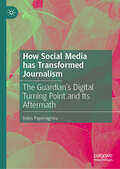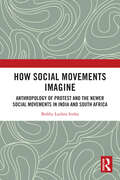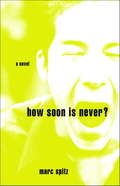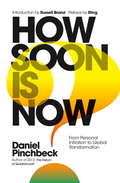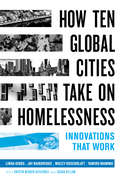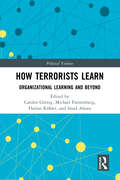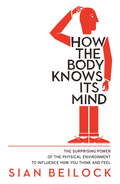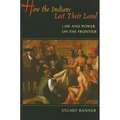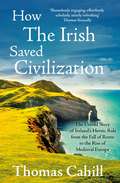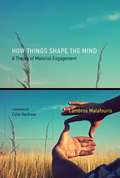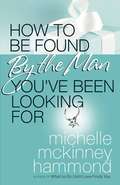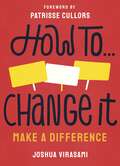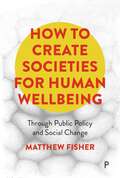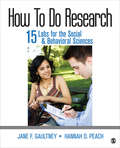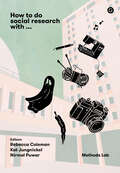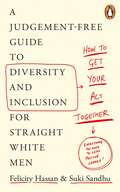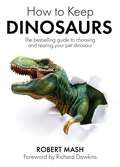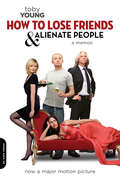- Table View
- List View
How Social Media has Transformed Journalism: The Guardian’s Digital Turning Point and Its Aftermath
by Vaios PapanagnouThis book explores the influence of social media on the transformation of institutional journalism. Grounded on a case study of The Guardian in the UK, the work is an in-depth look at how a leading news organisation navigated the challenges of the social media era. Drawing on interviews with Guardian journalists, Papanagnou demonstrates that the major change that social media effected on journalism has been the inculcation of journalists with the logic of branding. Journalists now actively brand themselves and their organisations as authoritative voices on public affairs; they emphasise their expertise in the stories they share across platforms, leveraging their reputations to establish credibility and connect with like-minded audiences. Ultimately, the author argues that the turn to branding represents a pragmatic solution to the problem that social media companies posed for journalism. By embracing networking technologies, journalists and their organisations have become increasingly tethered to big-tech. And, lacking the immense technological and financial resources of the digital platforms, news brands and their journalists have sought to counteract this dependency by wielding the power of their journalistic reputations.
How Social Movements Die
by Christian DavenportHow do social movements die? Some explanations highlight internal factors like factionalization, whereas others stress external factors like repression. Christian Davenport offers an alternative explanation where both factors interact. Drawing on organizational, as well as individual-level, explanations, Davenport argues that social movement death is the outgrowth of a coevolutionary dynamic whereby challengers, influenced by their understanding of what states will do to oppose them, attempt to recruit, motivate, calm, and prepare constituents while governments attempt to hinder all of these processes at the same time. Davenport employs a previously unavailable database that contains information on a black nationalist/secessionist organization, the Republic of New Africa, and the activities of authorities in the U. S. city of Detroit and state and federal authorities.
How Social Movements Imagine: Anthropology of Protest and the Newer Social Movements in India and South Africa (South Asia Migrations)
by Bobby Luthra SinhaThis book examines how micro contextual issues inspire collective social action forms against everyday situations of crises and crimes through an inter-disciplinary, ethnographic, and comparative research conducted among Bishnois and Indian South Africans.Exploring the role of the publics that practise and mobilise their social movement imaginations, the work delves into peoples’ ability to move beyond their immediate contexts and politicise multiple social spaces and discursive spheres around them to project their causes. Mapping an anti-poaching movement spearheaded by the Bishnois of Western Rajasthan in India and an anti-substance abuse movement led by the historical Indian diaspora of South Africa, the author argues that such contemporary forms of organised social action replete with alternative frames, symbols, and repertoires possess key requisites to be understood as the ‘Newer Social Movements’ of the Global South.The volume will be of great interest to scholars and researchers of social and protest movements, migration and diaspora studies, political science, social anthropology, and ethnography.
How Societies Remember
by Paul ConnertonIn treating memory as a cultural rather than an individual faculty, this book provides an account of how bodily practices are transmitted in, and as, traditions. Most studies of memory as a cultural faculty focus on written, or inscribed transmissions of memories. Paul Connerton, on the other hand, concentrates on bodily (or incorporated) practices, and so questions the currently dominant idea that literary texts may be taken as a metaphor for social practices generally. The author argues that images of the past and recollected knowledge of the past are conveyed and sustained by ritual performances and that performative memory is bodily. Bodily social memory is an essential aspect of social memory, but it is an aspect which has until now been badly neglected. An innovative study, this work should be of interest to researchers into social, political and anthropological thought as well as to graduate and undergraduate students.
How Soon Is Never?
by Marc SpitzThere is a light and it never goes out . . . or is there? Welcome to the big Reagan '80s, where ketchup is a vegetable and the Cold War looms large and chilly. If like Joe Green you were coming of age during this boom era, your main concerns include one or more of the following: a rainbow assortment of Polo shirts worn with the collar flipped up, K-Swiss tennis shoes, a new cable channel called MTV, and Top 40 radio. Stuck in the suburban haze of Long Island, New York, Joe Green knows there has got to be more to life. However, salvation is on the way, in the form of a quiffed-up quartet from Manchester, England, who take over the airways of a local radio station. Hearing the Smiths for the first time jerks Joe awake: Morrissey's wry and witty lyrics speak to him, and Johnny Marr's driven guitar chords get under his skin. He destroys his Phil Collins cassettes, pomades his hair into New Wave submission, studies up on his Oscar Wilde, and falls in love. He even shows up for dinner on time. That is, until his favorite band breaks up and then breaks his heart. Fast-forward some fifteen years. Joe Green is making a living as a rock journalist, still recovering from a wicked post-college smack addiction and slumming with youngsters who ironically "appreciate" the seminal '80s music that once gave his life meaning. It's too late to go home, or is it? What if Joe Green can get the Smiths back together? What if reuniting the long-broken-up band can reverse the passage of time and bring back the magic of youth? What if it helps him win the heart of the woman he loves? How Soon Is Never?is an acerbic, ingenious look at Reagan-era adolescence, the power of hearing a record that changes your life, and the dangers of nostalgia. Be prepared to see a bit of yourself in Joe Green.
How Soon is Now: From Personal Initiation to Global Transformation
by Sting Russell Brand Daniel PinchbeckWe are on the brink of an ecological mega-crisis, threatening the future of life on earth, and our actions over the next few years may well determine the destiny of our descendants. Between a manifesto and a tactical plan of action, How Soon is Now? by radical futurist and philosopher Daniel Pinchbeck, outlines a vision for a mass social movement that will address this crisis. Drawing on extensive research, Daniel Pinchbeck presents a compelling argument for the need for change on a global basis. The central thesis is that humanity has unconsciously self-willed ecological catastrophe to bring about a transcendence of our current condition. We are facing an initiatory ordeal on a planetary scale. We can understand that this initiation is necessary for us to evolve from one state of being – our current level of consciousness – to the next. Overcoming outmoded ideologies, we will realize ourselves as one unified being, a planetary super-organism in a symbiotic relationship with the Earth's ecology and the entire web of life. Covering everything from energy and agriculture, to culture, politics, media and ideology, How Soon Is Now? is ultimately about the nature of the human soul and the future of our current world. Pinchbeck calls for an intentional redesign of our current systems, transforming unjust and elitist structures into participatory, democratic, and inclusive ones. His viewpoint integrates indigenous design principles and Eastern metaphysics with social ecology and radical political thought in a new synthesis.
How Ten Global Cities Take On Homelessness: Innovations That Work
by Linda GibbsCreative solutions for global cities addressing their urgent homeless crises. This book takes on perhaps the most formidable issue facing metropolitan areas today: the large numbers of people experiencing homelessnes within cities. Four dedicated experts with first-hand experience profile ten cities—Bogota, Mexico City, Los Angeles, Houston, Nashville, New York City, Baltimore, Edmonton, Paris, and Athens—to explore ideas, strategies, successes, and failures. Together they bring an array of government, nonprofit, and academic perspectives to offer a truly global perspective. The authors answer essential questions about the nature and causes of homelessness and analyze how cities have used innovation and local political coordination to address this pervasive problem. Ten Global Cities will be an invaluable resource not only for students of policy and social work but for municipal, regional, and national policymakers; nonprofit service providers; community advocates and activists; and all citizens who want to collaborate for real change. These authors argue that homelessness is not an insurmountable social condition, and their examples show that cities and individuals working in coordination can lead the charge for better outcomes.
How Terrorists Learn: Organizational Learning and Beyond (Political Violence)
by Carolin Görzig Michael Fürstenberg Florian Köhler Imad AlsoosThis volume helps us understand the transformations of terrorist organisations, and the conflicts they are involved in, by broadening the perspective on what is considered terrorist learning. Using a variety of methodological approaches and empirical data, the volume offers a look at the clandestine inner lives of groups from different continents and ideological backgrounds in order to explore from whom they learn and how, and what the outcomes are. Their internal and external interactions are examined within their socio-political contexts to illuminate how they adapt to challenges or fail to do so. Unpacking the question of ‘how do terrorists learn’ helps us to grasp not only changes of violent means of action but also of operational and strategic approaches and, ultimately, even transformations of the ends pursued. The chapters demonstrate that terrorist learning is not principally different from that of other human organisations. The contributors draw on conceptual frameworks of organizational learning, but also broaden the scope beyond the organizational framework to acknowledge the variety of forms of informal and decentralized learning characteristic of much contemporary terrorism. This book will be of much interest to students of terrorism studies, violent extremism, organisational studies and International Relations.
How The Body Knows Its Mind: The Surprising Power Of The Physical Environment To Influence How You Think And Feel
by Sian BeilockIf you've ever gestured wildly with your hands in order to coax a word from your memory, or if you've sat up straighter in a meeting to feel more confident and alert, then you already know some of the ways the body can make an impact on the mind. But what if that's just the tip of the iceberg? Recent research shows that the extent to which the body affects the brain is greater than we'd ever imagined. Now How the Body Knows Its Mind reveals extraordinary ways you can use your body to improve your mind and performance in all areas of life.We often think of the brain as the master control centre - interpreting experiences, deciding what to do, and pulling the levers of the body. Sian Beilock, a leading expert on the brain science behind human performance and professor in the psychology department at the University of Chicago, turns our understanding of the mind upside down in How the Body Knows Its Mind.Your brain doesn't make that much of a distinction between what happens in your body and what happens in your mind. In fact, our bodies actually hack our brains. The way we move affects our thoughts, our decisions, and our preferences, and kids absorb more when they use their bodies as a learning tool. Called "embodied cognition," this new science illuminates the power of the body and its physical surroundings to shape how we think, feel, and behave: pacing around the room can enhance creativity; walking in nature boosts concentration skills; Botox users experience less depression; fit children score higher on tests in school.From the tricks used by advertisers to the ways body language can improve your memory to how to master public speaking, Beilock explains a wealth of fascinating interconnections between mind and body and shows how mastering them can make you happier, safer, and more successful.
How The Indians Lost Their Land: Law And Power On The Frontier
by Stuart BannerBetween the early seventeenth century and the early twentieth,nearly all the land in the United States was transferred from AmericanIndians to whites. This dramatic transformation has been understood in two very different ways--as a series of consensual transactions, but also as a process of violent conquest. Both views cannot be correct. How did Indians actually lose their land? <p><p> Stuart Banner provides the first comprehensive answer. He argues that neither simple coercion nor simple consent reflects the complicated legal history of land transfers. Instead, time, place, and the balance of power between Indians and settlers decided the outcome of land struggles. As whites' power grew, they were able to establish the legal institutions and the rules by which land transactions would be made and enforced. <p> This story of America's colonization remains a story of power, but a more complex kind of power than historians have acknowledged. It is a story in which military force was less important than the power to shape the legal framework within which land would be owned. As a result, white Americans--from eastern cities to the western frontiers--could believe they were buying land from the Indians the same way they bought land from one another. How the Indians Lost Their Land dramatically reveals how subtle changes in the law can determine the fate of a nation, and our understanding of the past.
How The Irish Saved Civilization: The Untold Story of Ireland's Heroic Role from the Fall of Rome to the Rise of Medieval Europe
by Thomas Cahill'Shamelessly engaging, effortlessly scholarly, utterly refreshing history of the Irish soul and its huge contribution to Western culture' Thomas KeneallyIreland played the central role in maintaining European culture when the dark ages settled on Europe in the fifth century: as Rome was sacked by Visigoths and its empire collapsed, Ireland became 'the isle of saints and scholars' that enabled the classical and religious heritage to be saved.In his compelling and entertaining narrative, Thomas Cahill tells the story of how Irish monks and scrines copied the mauscripts of both pagan and Christian writers, including Homer and Aristotle, while libraries on the continent were lost forever. Bringing the past and its characters to life, Cahill captures the sensibility of the unsung Irish who relaunched civilisation.
How The Other Half Lives
by Jacob RiisBehind nearly every adult who is accused of a crime, becomes addicted to drugs or alcohol, or who is severely mentally ill and acting out in public, there is usually at least one extremely stressed-out parent. This parent may initially react with the bad news of their adult child behaving badly with, "Oh no!" followed by, "How can I help to fix this?" A very common third reaction is the thought, "Where did I go wrong--was it something I said or did, or that I failed to do when my child was growing up that caused these issues? Is this really somehow all my fault?" These parents then open their homes, their pocketbooks, their hearts, and their futures to "saving" their adult child--who may go on to leave them financially and emotionally broken. Sometimes these families also raise the children their adult children leave behind: 1. 6 million grandparents in the U. S. are in this situation. This helpful book presents families with quotations and scenarios from real suffering parents (who are not identified), practical advice, and tested strategies for coping. It also discusses the fact that parents of adult children may themselves need therapy and medications, especially antidepressants. The book is written in a clear, reassuring manner by Dr. Joel L. Young, medical director of the Rochester Center for Behavioral Medicine in Rochester Hills, Michigan; with noted medical writer Christine Adamec, author of many books in the field. In the wake of the Newtown shooting and the viral popularity of the post "I Am Adam Lanza's Mother," America is now taking a fresh look, not only at gun control, but also on how we treat mental illness. Another major issue is our support or stigmatization of those with adult children who are a major risk to their families as well to society itself. This book is part of that conversation.
How Things Shape the Mind
by Colin Renfrew Lambros MalafourisAn increasingly influential school of thought in cognitive science views the mind as embodied, extended, and distributed, rather than brain-bound, "all in the head." This shift in perspective raises important questions about the relationship between cognition and material culture, posing major challenges for philosophy, cognitive science, archaeology, and anthropology. In How Things Shape the Mind, Lambros Malafouris proposes a cross-disciplinary analytical framework for investigating the different ways in which things have become cognitive extensions of the human body. Using a variety of examples and case studies, he considers how those ways might have changed from earliest prehistory to the present. Malafouris's Material Engagement Theory adds materiality -- the world of things, artifacts, and material signs -- into the cognitive equation definitively. His account not only questions conventional intuitions about the boundaries and location of the human mind but also suggests that we rethink classical archaeological assumptions about human cognitive evolution. Arguing that the understanding of human cognition is essentially interlocked with the study of the technical mediations that constitute the central nodes of a materially extended and distributed human mind, Malafouris offers a series of archaeological and anthropological case studies -- from Stone Age tools to the modern potter's wheel -- to test his theory. How do things shape the mind? Considering the implications of the seemingly uniquely human predisposition to reconfigure our bodies and our senses by using tools and material culture, Malafouris adds a fresh perspective on a foundational issue in the study of human cognition.
How Things Shape the Mind: A Theory of Material Engagement
by Lambros MalafourisAn account of the different ways in which things have become cognitive extensions of the human body, from prehistory to the present.An increasingly influential school of thought in cognitive science views the mind as embodied, extended, and distributed rather than brain-bound or “all in the head.” This shift in perspective raises important questions about the relationship between cognition and material culture, posing major challenges for philosophy, cognitive science, archaeology, and anthropology. In How Things Shape the Mind, Lambros Malafouris proposes a cross-disciplinary analytical framework for investigating the ways in which things have become cognitive extensions of the human body. Using a variety of examples and case studies, he considers how those ways might have changed from earliest prehistory to the present. Malafouris's Material Engagement Theory definitively adds materiality—the world of things, artifacts, and material signs—into the cognitive equation. His account not only questions conventional intuitions about the boundaries and location of the human mind but also suggests that we rethink classical archaeological assumptions about human cognitive evolution.
How To Be Found By The Man You've Been Looking For
by Michelle Mckinney HammondBestselling author Michelle McKinney Hammond, whose books have sold over 1. 3 million copies, encourages single women to place their need for love in perspective, take their lives off hold, live purposely, and gain a better understanding of how to relate successfully to men. In her candid, no-nonsense style, Michelle assures the reader that the journey toward finding a mate for life does not have to be filled with anxiety or regret. She warmly offers encouragement from her own life experiences and gleans godly principles from Ruth, a sister in the Bible who got her man, to show readers how to get the love they want. Those stuck in the dead-end dating scene, along with those on an involuntary relationship fast, need to know that marriage could very well be on the horizon. . . if only they learn how to be found by the man they've been looking for. Formerly titled Ending the Search for Mr. Right.
How To Be Gay
by David M. HalperinA pioneer of LGBTQ studies dares to suggest that gayness is a way of being that gay men must learn from one another to become who they are. The genius of gay culture resides in some of its most despised stereotypes—aestheticism, snobbery, melodrama, glamour, caricatures of women, and obsession with mothers—and in the social meaning of style.
How To Change It: Make a Difference (Merky How To #2)
by Joshua VirasamiIntroducing the new ‘How To…’ series from #Merky Books: unlock your potential with our short, practical pocket-sized guides._______________________________________________________How to Change It: your indispensable guide to activismIs it possible to create real change? How can we as individuals help to solve some of the biggest issues of today? How can we overcome injustice and inequality wherever we are? Where does power sit, and how can we get it?How to Change It provides the answers to these questions, and many more. In three simple steps - educate, organise and agitate - artist and organiser Joshua Virasami sets out several lessons for successful campaigning, drawing on the experience and actions of a number of activist and political movements, including Extinction Rebellion, Occupy and Black Lives Matter.Written by Joshua VirasamiIntroduced by Patrisse Cullors: artist, organiser and freedom fighter from Los Angeles and co-founder of Black Lives Matter. She is the author of critically acclaimed When They Call You a Terrorist: A Black Lives Matter Memoir._______________________________________________________Designed to inspire and encourage readers to unlock their potential and provoke change, the How To series offers a new model in publishing, helping to break down knowledge barriers and uplift the next generation.Creatively presented and packed with clear, step-by-step, practical advice, this series is essential reading for anyone seeking guidance to thrive in the modern world. Curate your bookshelf with these collectible titles.
How To Create Societies for Human Wellbeing: Through Public Policy and Social Change
by Matthew FisherWellbeing is a hot topic: governments, psychologists and a thousand self-appointed ‘experts’ all claim to promote it and yet our societies are experiencing record levels of mental distress and ill-health. Why? Matthew Fisher presents a compelling new perspective on psychological wellbeing informed by evidence on human stress responses. He shows how our mental health is shaped by the social and cultural conditions in which we all live. Developing arguments and strategies for a society truly committed to wellbeing, this book offers new ways to understand the problems facing modern societies and ways to respond through political and social change.
How To Do Research: 15 Labs for the Social & Behavioral Sciences
by Jane F. Gaultney Hannah D. PeachDesigned to help students make the leap from learning about research to doing research, this manual provides an easy-to-understand walkthrough of the entire research process, from selecting a topic and conducting a literature review through presenting an APA-style paper or presentation. All of the 15 cross-disciplinary labs included are appropriate for use in the social, behavioral, and health sciences, and follow a consistent format: objective, description of a journal article, canned data, examples of what output should look like, pointers on interpreting the output, and a suggested activity for those who wish to collect their own data.
How To Do Research: 15 Labs for the Social & Behavioral Sciences
by Jane F. Gaultney Hannah D. PeachDesigned to help students make the leap from learning about research to doing research, this manual provides an easy-to-understand walkthrough of the entire research process, from selecting a topic and conducting a literature review through presenting an APA-style paper or presentation. All of the 15 cross-disciplinary labs included are appropriate for use in the social, behavioral, and health sciences, and follow a consistent format: objective, description of a journal article, canned data, examples of what output should look like, pointers on interpreting the output, and a suggested activity for those who wish to collect their own data.
How To Do Social Research With (Goldsmiths Press / Methods Lab)
by Rebecca Coleman Nirmal Puwar Kat JungnickelA guide to the doing of critical and creative research with a range of unusual means to apprise places and build ethical relationships.This catalogue of methods draws on the wealth of cutting-edge critical and creative social research from the Goldsmiths Sociology Department to offer an engaged guide to doing research with a range of unexpected relations. The collection focuses on multiple assemblages of objects, media, materials, practices, relations, devices, and atmospheres, spanning methods and topics involving food to activism, knitting to ghosts, theater to documents, collaging to corridors. Through hands-on discussions of the practicalities, ethics, and politics of doing social research, the catalogue showcases a wide range of examples of what methods might mean and do. It builds a case for an understanding of contemporary social research as interdisciplinary, responsive, dynamic, vital, and urgent in studying and shaping social worlds. Goldsmiths Sociology Department is internationally recognized as being at the forefront of some of the most daring, original and unconventional methodological innovation. Their unbounded approach to social research offers textured yet clear paths through the problems and issues before us, as contributors present the methodological puzzles they have become knotted with. The short and imaginative case studies offer new ways of teaching, learning, and doing lively and rigorous research. This is research as close-up observations, infrastructural interventions and imaginative play. How to Do Social Research With … will be essential for anyone interested in expanding their repertoire of social research methods.
How To Get Your Act Together: A Judgement-Free Guide to Diversity and Inclusion for Straight White Men
by Suki Sandhu Felicity Hassan'Obligatory reading for anyone - straight, white and male or otherwise - who wants to do better but doesn't know where to start.' - People Management'A pivotal guide for going from awareness to action in creating a more diverse and inclusive workplace and society.' - Marc Benioff, CEO of Salesforce--------EVERYTHING YOU NEED TO CREATE AND LEAD AN INCLUSIVE, DIVERSE TEAMThe business case for diversity and inclusion is clear - it drives innovation, profit and employer brand. But how can male white leaders help implement this change? There's no denying it's difficult - perhaps you feel left out of the conversation, afraid to make mistakes, and confused about the evolving language of diversity and inclusion.In this practical guide, leading diversity specialists Felicity Hassan and Suki Sandhu OBE teach you how to create an inclusive environment for your employees and have educated conversations about diversity, navigating what can sometimes be tricky territory with humour and heart.--------'A must-read and a powerful call to seize the opportunity that lies in embracing and celebrating people for who they are.' - Richard Branson, CEO & Founder of The Virgin Group'It takes a good deal of self-awareness and continuous learning to really ingrain the behavioural changes that are needed. This book holds up a mirror and then guides us - skilfully and persuasively - to the actions we all need to be taking.' - Alan Jope, CEO of Unilever
How To Keep Dinosaurs: The perfect mix of humour and science
by Robert Mash'Who could resist a handbook about potential pets that has a little symbol for "likes children" and a separate one for "likes children to eat"... wonderful' GUARDIANHollywood and the popular press would have us believe that all dinosaurs are gigantic, hostile and untameable. In fact, there are many species that make charming and even useful companions: Velociraptor - a splendid, loyal, fierce, friendDeinonychus - will not eat dog food (dogs are another matter)Tyrannosaurus - least suitable to keep; will need special licenceOrnithomimus - an appealing first dinosaur for the child anxious for her first rideThis book advises you which dinosaur is right for you and your home, from the city apartment dweller looking for a lap pet, to the country estate owner looking to tighten up on security. HOW TO KEEP DINOSAURS is a bestselling guide, packed with the sort of information keen dinosaur keepers crave - from feeding and housing to curing common ailments, breeding and showing your animal. The author, a zoologist with extensive experience of dinosaurs, has provided a timely and much-needed source book for all those who keep dinosaurs and for the huge numbers who are contemplating getting one. It is as essential to every dinosaur keeper as a stout shovel and a tranquilliser rifle.
How To Lose Friends And Alienate People: A Memoir
by Toby YoungIn 1995 high-flying British journalist Toby Young left London for New York to become a contributing editor at Vanity Fair. Other Brits had taken Manhattan--Alistair Cooke, Tina Brown, Anna Wintour--so why couldn't he?But things didn't quite go according to plan. Within the space of two years he was fired from Vanity Fair, banned from the most fashionable bar in the city, and couldn't get a date for love or money. Even the local AA group wanted nothing to do with him.How to Lose Friends and Alienate People is Toby Young's hilarious and best-selling account of the five years he spent looking for love in all the wrong places and steadily working his way down the New York food chain, from glossy magazine editor to crash-test dummy for interactive sex toys. A seditious attack on the culture of celebrity from inside the belly of the beast, How to Lose Friends and Alienate People is also a "nastily funny read." --USA Today
How To Make Black America Better
by Tavis SmileySmiley, a political commentator and talk-show host on the BET television network, has gathered 28 brief essays from prominent African-American writers, academics, politicians, and celebrities, who pick apart issues such as affirmative action, crime, political power, economic independence, and race relations. These are sandwiched between Smiley's "Ten Challenges to Black America" and excerpts from a panel discussion, held in Los Angeles before the 2000 Democratic National Convention, with Magic Johnson, Johnetta Cole, Cornel West, Maxine Waters, Jesse Jackson, and other speakers. Annotation c. Book News, Inc. , Portland, OR (booknews. com)
